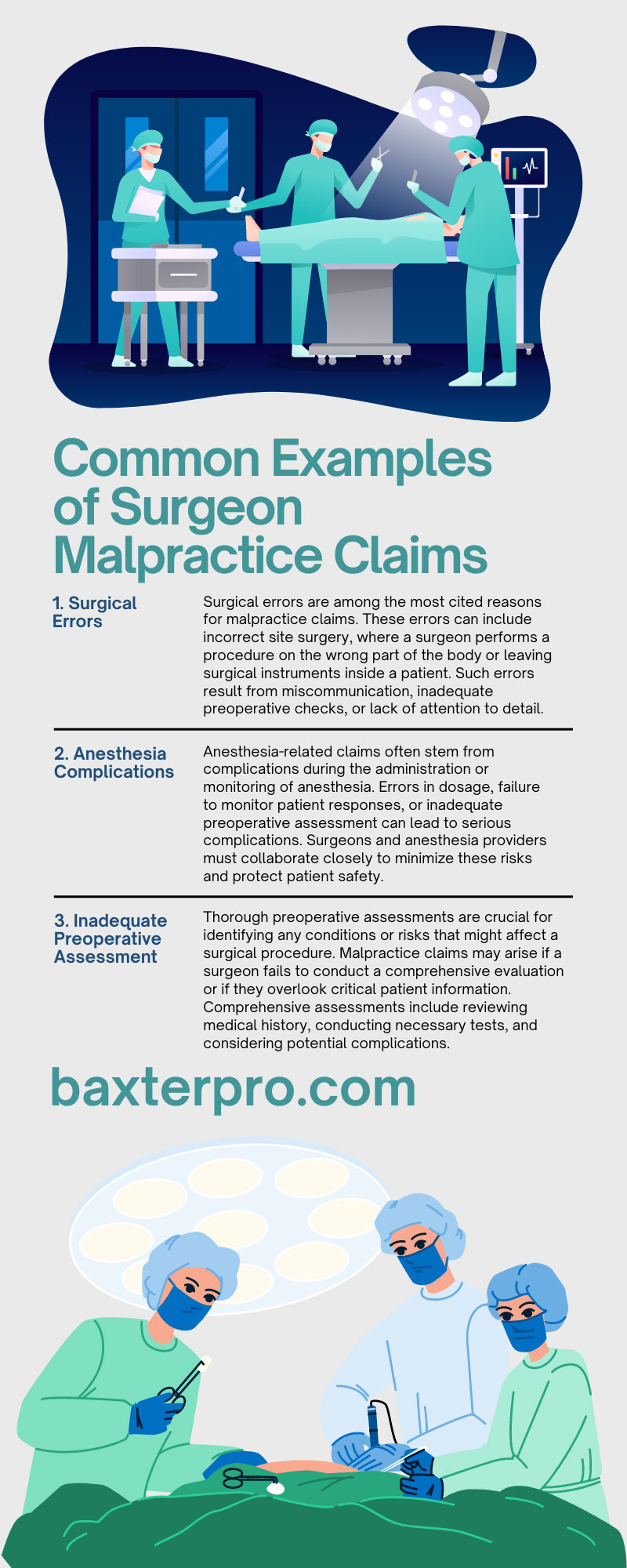
Common Examples of Surgeon Malpractice Claims
Sep 12 2024The healthcare industry relies on the precision and skill of surgeons. However, despite their expertise, surgeons can face malpractice claims that reflect lapses in care or judgment.
Understanding these common examples of surgeon malpractice claims can help healthcare professionals navigate the complexities of medical liability and improve patient safety. Here are several common scenarios that can lead to malpractice claims, along with insights into mitigating those risks.
1. Surgical Errors
Surgical errors are among the most cited reasons for malpractice claims. These errors can include incorrect site surgery, where a surgeon performs a procedure on the wrong part of the body or leaving surgical instruments inside a patient. Such errors result from miscommunication, inadequate preoperative checks, or lack of attention to detail.
2. Anesthesia Complications
Anesthesia-related claims often stem from complications during the administration or monitoring of anesthesia. Errors in dosage, failure to monitor patient responses, or inadequate preoperative assessment can lead to serious complications. Surgeons and anesthesia providers must collaborate closely to minimize these risks and protect patient safety.
3. Inadequate Preoperative Assessment
Thorough preoperative assessments are crucial for identifying any conditions or risks that might affect a surgical procedure. Malpractice claims may arise if a surgeon fails to conduct a comprehensive evaluation or if they overlook critical patient information. Comprehensive assessments include reviewing medical history, conducting necessary tests, and considering potential complications.
4. Failure To Obtain Informed Consent
Obtaining informed consent is a fundamental requirement before performing any surgical procedure. Surgeons must clearly explain the risks, benefits, and alternatives of a procedure to the patient. Claims often arise when patients allege they weren’t adequately informed about potential outcomes or complications, affecting their ability to make an informed decision.
5. Postoperative Complications
Postoperative complications can lead to malpractice claims if they’re a result of substandard care. Issues such as infections, delayed wound healing, or complications related to improper postoperative instructions can contribute to claims. Surgeons must monitor patients closely after surgery and provide detailed instructions for postoperative care.
6. Diagnostic Errors
Diagnostic errors occur when a surgeon misdiagnoses a condition or fails to diagnose a condition that they should have identified. These errors can lead to inappropriate or delayed treatment, resulting in adverse patient outcomes. Surgeons should work closely with diagnostic teams to obtain accurate and timely diagnoses.
7. Inadequate Surgical Technique
The use of suboptimal surgical techniques or equipment can result in malpractice claims. Inadequate surgical methods, poor decision-making during surgery, or the use of outdated or faulty equipment can lead to patient harm. Surgeons must stay updated on best practices and advancements in surgical techniques to provide high-quality care.
8. Failure To Refer to Specialists
In some cases, surgeons may face claims for failing to refer patients to specialists when needed. If a surgeon encounters a condition outside their expertise and does not refer the patient to a specialist, it can lead to suboptimal care and negative outcomes. Proper referral and collaboration with specialists are essential for comprehensive patient care.
9. Unrecognized Complications
Surgeons may face malpractice claims if they don’t recognize and address complications that arise during or after a procedure. These complications can include not promptly identifying signs of infection, bleeding, or other adverse effects. Early recognition and management of complications helps prevent further patient harm.
10. Poor Communication
Effective communication between the surgical team, patients, and other healthcare professionals is critical. Malpractice claims often result from poor communication, which can cause misunderstandings, errors, and inadequate care. Surgeons should prioritize clear and consistent communication to keep all team members and patients on the same page.
11. Inadequate Surgical Documentation
Surgical practices must have accurate and comprehensive documentation procedures. Inadequate or incomplete surgical documentation can lead to malpractice claims, especially if it results in confusion about the surgical procedure or postoperative care.
Proper documentation includes detailed records of the surgical procedure, patient consent, and any complications or deviations from the planned procedure. In the event of a dispute, thorough documentation can provide essential evidence to support the surgeon’s actions and decisions.
Surgeons should document all aspects of the surgery and regularly update their records to reflect any changes or observations made during the procedure.
12. Inconsistent Follow-Up Care
Inconsistent or insufficient follow-up care can also lead to malpractice claims. Postsurgery follow-up is crucial for monitoring the patient’s recovery and addressing any issues that arise after the procedure.
Claims may arise if a patient doesn’t receive timely follow-up care or if the surgeon fails to address new symptoms or complications. Surgeons should establish clear follow-up protocols and maintain regular contact with patients to monitor their recovery.
Effective follow-up care allows you to identify any emerging issues and manage them promptly, reducing the risk of complications and subsequent malpractice claims.
Surgeon Malpractice Insurance: What You Should Know
As you can see, it’s essential for every surgeon to carry malpractice insurance coverage. It’s an essential safeguard for medical professionals against the financial repercussions of malpractice claims.
This type of insurance provides coverage for legal defense costs, settlements, and judgments resulting from allegations of professional negligence. Understanding the basics of surgeon malpractice insurance helps practitioners make informed decisions about their coverage needs and protection.
Which Type of Surgical Malpractice Insurance Should I Get?
Choosing the right malpractice insurance involves evaluating several factors, including the surgeon’s specialty, practice size, and risk profile. High-risk specialties may require higher coverage limits due to the increased likelihood of claims.
Additionally, surgeons should consider the scope of coverage, including whether it extends to various types of claims, such as those involving surgical errors or failure to obtain informed consent.
Securing adequate malpractice insurance is crucial for protecting a surgeon’s financial and professional future. Working with experienced insurance providers can help you find coverage tailored to your specific needs and maintain comprehensive protection against potential claims.
Baxter & Associates: Helping Surgeons Find Insurance Coverage
Navigating the complexities of surgical practice requires vigilance and adherence to medical standards to prevent malpractice claims. Understanding common examples of surgeon malpractice claims, such as surgical errors, anesthesia complications, and diagnostic errors, helps healthcare professionals minimize risk and improve patient outcomes.
Maintaining high standards of care, thorough assessments, and effective communication are also essential to mitigating these risks. Furthermore, healthcare professionals should consider securing adequate coverage from a trusted medical malpractice insurance company.
Baxter and Associates will help you find the best coverage that protects your practice against potential claims. Contact us today to begin your search for the perfect insurance coverage!




